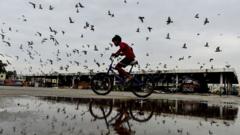A recent prohibition on feeding pigeons in Mumbai has become a significant point of contention among civic authorities, health activists, and bird enthusiasts. As the city grapples with public health concerns tied to pigeon droppings, hundreds have taken to the streets in protest against the closure of traditional pigeon feeding areas known as kabutarkhanas.
During protests, demonstrators clashed with police, resulting in brief detentions of activists upset over the ban, which authorities argue is necessary to mitigate health risks associated with pigeon droppings. The outrage is felt not just in Mumbai; other Indian cities like Pune and Thane have also pursued similar measures, as have global cities such as Venice and Singapore.
For many residents, pigeons symbolize cultural heritage and community bonding. The Jain community, who uphold feeding pigeons as a religious act, have been particularly vocal against the restrictions, asserting that such bans disregard spiritual traditions. In urban environments like Delhi and Mumbai, pigeons are regularly depicted in film and art as part of the cities' identities.
However, public health experts warn of the dangers posed by an overpopulation of pigeons, which can result in serious respiratory illnesses due to prolonged exposure to droppings. The rapid increase in pigeon populations—over 150% in the past two decades—raises concerns about the ecological impacts of their dominance in urban spaces.
Some residents, including long-time pigeon feeders, argue that feeding these birds fosters community and compassion. Yet, as public health officials highlight the need for sanitary conditions, a dialogue about balancing the health risks with cultural traditions is emerging.
The Bombay High Court has dismissed appeals against the ban, prioritizing public health, while also establishing a committee to explore possible compromises, such as regulated feeding times. Stakeholders are now considering options that respect both the rights of birds and the well-being of urban populations, reflecting a growing awareness of the complexities of urban wildlife management.
Ultimately, the ongoing discourse emphasizes the need for innovative solutions to reconcile the coexistence of people and birds in crowded urban environments, underlining the poignancy of cultural connections in times of public health crises.




















